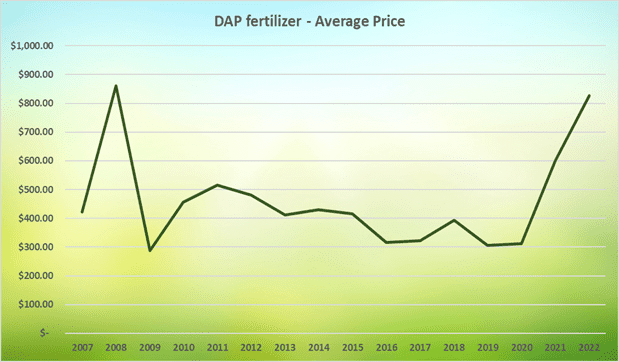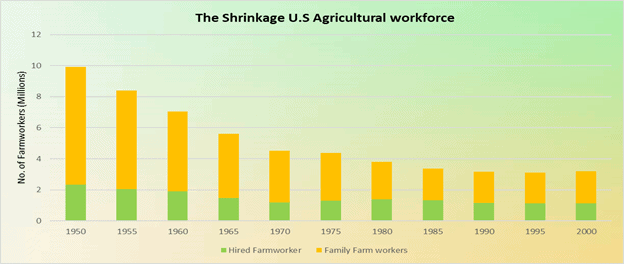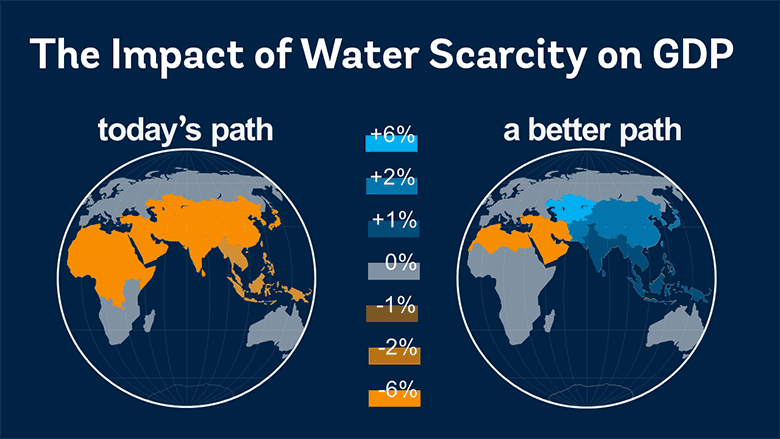Farm inputs refer to all the resources required in the process of crop production such as seeds, fertilizer, fuel, labor, machines, and water. Since farmers are affected by the hike in the prices of these agricultural inputs, it will directly impact the prices of food for the consumers.
According to the USDA (United States Department of Agriculture), the cost of production will continue to rise in 2022. According to the current analysis, the total production expense is estimated to rise by 5%. This is after a 9% increase from 2020 to 2021. As the agricultural sector continues to see a rise in farm input costs such as fertilizers and fuel prices, the total production cost increases simultaneously. As a result, consumers are seeing a sudden hike in food prices. The hike in the prices of agricultural inputs is setting new records every day and is likely to impact the production costs of 2022 and 2023
Provided below is a detailed analysis of inputs used in agriculture and the reasons for the price hike.
Fertilizer Prices
Russia and Ukraine are amongst the most important agricultural producers in the world and export large quantities of fertilizers around the globe. Although supply from Russia to other countries has not stopped, however, various disruptions caused by sanctions (Belarus and Russia), and export restrictions (China) are the main reasons for the lack of supply and increase in the prices of fertilizers. High fertilizer demand recorded higher price levels since the beginning of the pandemic and geopolitical risks also triggered the prices of fertilizers. It is also observed that phosphate and potash fertilizer prices are closer to the price levels of 2008.

Hike in Seed prices
There is a rapid rise in U.S. seed prices. The major cause of the price rise is due to lower supply caused by poor weather conditions in North Dakota, which has reduced supply since last year. As per the Global Trade Article, North Dakota contributes 85% of total American rape seed output which is brutally affected by bad weather conditions in North Dakota and disruption in supplies from Ukraine. The ongoing drought conditions, heat, and excess humidity coupled with rainfall deficit are also intense factors that contribute to the rising seed prices as the quality of the soil continues to be poor for harvesting. Simply put, the fields dry down more slowly under normal weather conditions, making the soil fit for production.
Hike in Fuel Cost
According to the U.S. Energy Information Administration (EIA), gasoline prices hit a new record and rose above $5.004 in June 2022. The prices of diesel are also increasing beyond expectations. Reserve prices rose to $5.718 per gallon in June 2022. The current price of fuel is more than two times the price paid before 2020. The U.S. economy has been trying to get back on track after the pandemic slowed it down, however, the U.S. is currently facing additional hurdles. The Russia - Ukraine war is currently the biggest reason for soaring prices as the supply chain is hampered and the demand continues to grow. Farmers are one of the worst affected parts of the society by fuel price hikes as their total production cost is getting expensive day by day. Diesel and gasoline are the two main components of farm production as farmers transport their products to the market and purchase farm inputs to do farming. High fuel prices are ultimately causing the food to be more expensive for the consumers. Furthermore, it is necessary to keep an eye on the more impactful factors such as hurricanes caused by climate change. If any of the diesel and petroleum refineries are hit by hurricanes, the supply would go down further, causing the demand to rise, and prices to go higher.
Farm Labor Shortage
U.S. farmers have been struggling with labor shortages for years. The agricultural industry has been dealing with widespread worker shortages due to many factors such as declining interest in agricultural employment and immigration laws. As a result, the gap between the jobs available and the people filling these jobs is widening. The U.S. agricultural workforce comprises two groups of workers:
- Self-employed and their family members
- Hired workers

According to the USDA National Agricultural Statistics Service, the farm labor survey reported a decline of 73% in self-employed family workers from 1950 to 2000, and a decline of 52% in hired workers within the same period in 2018. The agricultural industry experienced a 7% decline in hired workers and a 5% increase in labor wages as a shortage of labor triggered higher labor wages. The decline of interest in working in the agricultural industry is due to an increase in education and other job opportunities available to the workers as corporate jobs offer more pay in comparison to the agricultural industry. Immigration policies are also a key factor to reduce the number of workers available for the agricultural industry. According to the Illegal Immigration Reform and Immigrant Responsibility Act of 1996, immigrants who are unlawfully present in the U.S. for 180days but under the 365days must remain outside the United States for three years until stated otherwise by law. This act was designed to improve border control and restrict criminals from smuggling fraudulent immigration-related documents into the United States of America. Almost half of the farm laborers were undocumented immigrants who have now been restricted from working under this law. This resulted in a labor shortage.
Water Scarcity

There is no life without water. Human beings can survive three weeks without food, but only three days without water. Now we are in a situation where water scarcity is the biggest problem all over the world. Water availability is a must for crop production, there is no alternative to water to irrigate the crops and keep the product intact for the growing population. According to the International Water Management Institute, agriculture accounts for about 70% of global water withdrawals. It is constantly competing with domestic, industrial, and environmental uses for a scarce water supply. Water management is an essential step to take for managing the problem of scarcity. Water waste should be reduced to overcome the problem of water crisis as food production is dependent on farming, and it may result in a hike in food prices for the consumers. Farmers are greatly affected by the water crisis as irrigation is a top concern for them to produce food. Bad weather conditions, global warming, and drought are the main drivers of water scarcity for farmers. Water is a precious resource and cannot be alternated. It is the foundation for a developed economy as water is the resource used in almost every sector of the economy. Water demand is rising rapidly and challenging food availability at the global level. To sustain a more productive agricultural sector that is resilient to water risks, the government initiated several actions, at watershed and national levels to:
- Strengthen and enforce existing water regulations
- Create incentives for farmers to improve their water use and better manage the use of polluting agricultural inputs
- Remove policies that support excessive use of water and polluting activities because if not, it will have a brutal effect on the GDP.
The growing water crisis is a humanitarian crisis, it also has striking economic implications. By 2050, water scarcity in some regions could impact GDP growth by up to 11.5%, as per the World Bank estimates.
Hike in Machinery Cost

Machinery and equipment are the mandatory investments in farm businesses as it is the new technology that reduces the pressure on farmers caused by manual labor. However, the constant rise in the prices of the machines and equipment used in farming creates a burden on farmers. The use of machinery and modern technology provide a positive impact on the output value and income of the farmers. the hike in prices has led to truck tractor prices to go up by 58% YOY in the U.S. according to Ritchie Bros. April Market Trends Report. So, good machinery managers can control machinery and power costs per acre. Making smart decisions about how to acquire machinery, when to trade, and how much capacity to invest in can reduce machinery costs by as much as $50 per acre. All these decisions require accurate estimates of the costs of owning and operating farm machinery.
The Bottom Line
Farm inputs which include seeds, fertilizer, fuel, labor, machines, and water may likely affect the price policy of all the sectors and the rest of the economy as agriculture is the foundation of an economy. The government needs to ensure rational utilization of production resources and recommend minimum support prices for the primary resources used in agricultural practices. This way the total cost of production will not be affected, and we will see stability in inflation which will also provide additional subsidies to the farmers.
